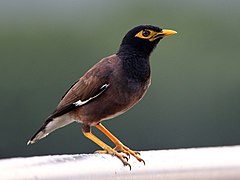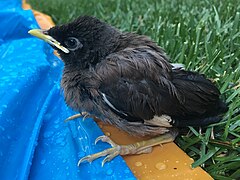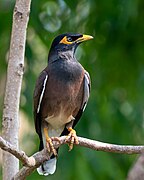家八哥
| 家八哥 | |
|---|---|
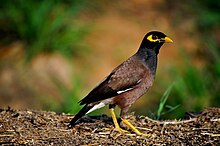
| |

| |
| 科学分类 | |
| 界: | 动物界 Animalia |
| 门: | 脊索动物门 Chordata |
| 纲: | 鸟纲 Aves |
| 目: | 雀形目 Passeriformes |
| 科: | 椋鸟科 Sturnidae |
| 属: | 八哥属 Acridotheres |
| 种: | 家八哥 A. tristis
|
| 二名法 | |
| Acridotheres tristis (Linnaeus, 1766)
| |
| 亚种 | |
|
Acridotheres tristis melanosternus | |

| |
| 家八哥的原产地(蓝色) | |
| 异名 | |
|
Paradisaea tristis Linnaeus, 1766 | |

家八哥(学名:Acridotheres tristis),俗称禽吉了,为椋鸟科八哥属的鸟类,原产于中亚、南亚和中国[2],后来引入美洲、非洲等世界其他地区[3]。
家八哥是杂食性鸟类,喜欢开放的树林,并且有强烈的领地意识,对城市地区环境适应良好。
家八哥的分布范围增长速度如此之快,以至于在2000年,国际自然保护联盟物种存续委员会将其列为全球最具入侵物种之一,也是唯一列入《全球最具危害的外来入侵物种100种》中的三种鸟类之一,对生物多样性、农业和人类利益构成威胁。[4] 特别是在澳洲,该物种对当地生态系统造成严重威胁,并于2008年被评为“最重要的害虫/问题”。[5]
分类
[编辑]1760年,法国动物学家马蒂兰·雅克·布里松在他的《鸟类学》(Ornithologie)中描述了家八哥,基于一个他误认为是在菲律宾采集的标本。他使用了法语名称Le merle des Philippines 和拉丁名Merula Philippensis。[6] 虽然布里松创造了拉丁名,但它们不符合双名法,因此不被国际动物命名法委员会承认。[7]
瑞典博物学家卡尔·林奈在1766年更新了他的《自然系统》,为第12版新增了240个由布里松先前描述的物种。[7] 其中之一便是家八哥。林奈提供了简短的描述,并命名了双名Paradisea tristis,并引用了布里松的著作。[8] 随后,模式产地被更正为印度南部的朋迪榭里。[9]种小名tristis 在拉丁语中意为“悲伤”或“忧郁”。[10] 现今这个物种被归入法国鸟类学家路易·皮耶·维亚律在1816年引入的八哥属(Acridotheres)。[11] 属名Acridotheres 来自希腊语ακριδος (akridos),意为蝗虫,和θηρας (theras),意为猎手。
- 印度八哥 (A. t. tristis) (林奈,1766年) – 分布于南哈萨克斯坦、土库曼、东伊朗至南中国、印度支那、马来半岛和南印度。该亚种也被引入夏威夷和北美。其分布范围的西北部群体有时被单独列为亚种A. t. neumanni,而尼泊尔和缅甸的群体被描述为A. t. tristoides。[13]
- 斯里兰卡八哥 (A. t. melanosternus)(莱格,1879年) – 斯里兰卡
斯里兰卡亚种melanosternus 比印度亚种tristis颜色更深,初级覆羽一半黑一半白,且面颊的黄色斑块较大。[14][15]
描述
[编辑]
家八哥特征明显,棕色的身体、黑色的头部,眼后有一片裸露的黄色斑块。喙和腿呈鲜黄色。外侧初级羽毛有一个白色斑块,翅膀下衬羽也是白色的。雌雄鸟相似,通常成对出现。[16] 家八哥遵循格洛格氏定律,来自印度西北部的鸟比来自印度南部的同类颜色更淡。[14][15]
叫声
[编辑]家八哥的鸣叫声包括呱呱叫、尖叫、唧唧喳喳、咔嗒声、口哨和“咆哮”,且常在唱歌时蓬起羽毛、点头。当附近有掠食者或准备飞翔时,家八哥会尖叫向其配偶或其他鸟类发出警告。[17] 家八哥因其歌唱和“说话”能力而成为受欢迎的笼中鸟。入夜前,家八哥会集体鸣声,这被称为“集体噪音”。[18]
形态测量
[编辑]形态测量。[14]
- 身体长度:23厘米(9.1英寸)
| 参数/性别 | 公鸟 | 母鸟 |
|---|---|---|
| 平均体重 (克) | 109.8 | 120–138 |
| 翼弦长 (毫米) | 138–153 | 138–147 |
| 喙长 (毫米) | 25–30 | 25–28 |
| 跗跖长 (毫米) | 34–42 | 35–41 |
| 尾长 (毫米) | 81–95 | 79–96 |
分布与栖地
[编辑]
家八哥原产于亚洲,其最初的分布范围包括伊朗、巴基斯坦、印度、尼泊尔、不丹、孟加拉和斯里兰卡、阿富汗、乌兹别克斯坦、塔吉克斯坦、土库曼斯坦、缅甸、马来西亚、新加坡、泰国半岛、印度支那、日本(包括日本本土和琉球群岛)以及中国。[14][19]

家八哥已被引入到世界上许多其他地方,如加拿大、澳洲、以色列、纽西兰、新喀里多尼亚、斐济、美国(仅南佛罗里达州[20])、南非、哈萨克斯坦、吉尔吉斯斯坦、乌兹别克斯坦、开曼群岛、印度洋的岛屿(包括塞舌尔——该物种曾在当地被高成本根除,[21]模里西斯、留尼旺、马达加斯加、马尔地夫、安达曼-尼科巴群岛以及拉克沙群岛群岛)和大西洋的岛屿(如阿森松岛和圣赫勒拿、太平洋岛屿以及赛普勒斯,2022年2月[14][页码请求])。家八哥的分布范围不断扩大,至2000年,国际自然保护联盟物种存续委员会将其列为全球最具危害的入侵物种之一。[4]
它通常栖息于开放的树林、耕地和人类居住区附近。虽然家八哥是一种适应力强的物种,但在新加坡,由于与入侵的爪哇八哥竞争,其数量异常增多,且被视为害虫(当地称其为gembala kerbau,意思是“水牛牧人”)。[22]
家八哥在城市和郊区环境中繁荣生长;例如,在坎培拉,于1968年至1971年间释放了110只家八哥。到1991年,坎培拉的家八哥种群密度平均为每平方公里15只。[23] 仅三年后,另一项研究发现同一地区的平均种群密度达到每平方公里75只。[24]
家八哥在雪梨和坎培拉的城市和郊区环境中的成功,可能得益于其进化起源;由于家八哥在印度的开放林地中进化,因此它预先适应了有高大垂直结构且地面植被稀少的栖地,[25] 这些特征与城市街道和自然保护区非常相似。
家八哥(以及欧洲椋鸟、家麻雀和野鸽)对城市建筑物造成滋扰;它们的巢穴会堵塞排水沟和排水管,导致建筑外部的水损坏。[26]
行为
[编辑]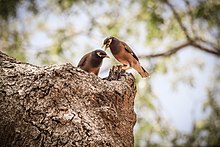

繁殖
[编辑]

家八哥被认为终生配对。它们依据所在位置,在一年中的大部分时间内繁殖,通常在树洞或墙洞中筑巢。它们在喜马拉雅山脉的海拔0—3,000米(0—9,843英尺)处繁殖。[14]
正常的卵巢大小为4至6颗蛋。蛋的平均大小为30.8乘21.99毫米(11⁄4乘3⁄4英寸)。孵卵期为17至18天,雏鸟离巢期为22至24天。[14]噪鹃有时会对这种鸟类进行巢寄生。[27] 家八哥使用的筑巢材料包括树枝、根、粗麻和垃圾。家八哥已知会使用纸巾、锡箔和脱落的蛇皮来筑巢。[14]
在繁殖季节,1978年4月至6月普纳的家八哥日间活动时间分配如下:筑巢活动占42%,环境扫描占28%,移动占12%,觅食占4%,发声占7%,梳理相关活动、互动及其他活动占7%。[28]
家八哥会使用啄木鸟、鹦鹉等的巢,并容易接受巢箱;有纪录显示家八哥会将之前巢中的雏鸟用喙叼走,有时甚至不会使用空置的巢箱。这种侵略性行为促成了其作为入侵物种的成功。[29]
还有一些证据表明,在引入的环境中,家八哥更倾向于选择在人为改造的结构中筑巢,而不是在自然树洞中,这与本地鸟种相比尤其明显。[30]
食物与觅食
[编辑]像大多数椋鸟一样,家八哥是杂食性鸟类。它们以昆虫、蛆、蚯蚓、蜘蛛、甲壳类、爬行动物、小型哺乳动物、种子、谷物、水果、花蜜和花瓣,以及人类居住区丢弃的废弃物为食。[31] 它们会在草地上觅食昆虫,特别是蚱蜢,这也是其属名Acridotheres“蚱蜢猎手”的由来。不过,它们吃多种昆虫,大多数是从地面上捡来的。[14][32] 它们还是像Salmalia和Erythrina这类花卉的传粉者。它们步行在地面上,有时跳跃,并抓住被放牧的牛或燃烧的草地惊动的昆虫觅食。[14] 它们会捕食其他鸟类的蛋和幼鸟,如夏威夷棕榈雀(Loxops coccineus)。[31] 有时候,它们甚至会在浅水中涉水捕鱼。[31] 由于居住在靠近人类建筑物的栖地,家八哥也会出现在路边以车祸的动物尸体为食。[33]
栖息行为
[编辑]家八哥全年都会集体栖息,通常会与丛林八哥、粉红椋鸟、家鸦、丛林鸦、牛背鹭、红领绿鹦鹉等鸟类混群栖息。栖息的群体规模从少于一百只到数千只不等。[34][35] 家八哥到达栖地的时间从日落前开始,并在日落后结束。它们在日出前离开。到达和离开的时间及时间跨度、最终在栖地安定的时间、集体睡眠的持续时间、群体大小和数量会随季节变化。[18][36][37]
集体栖息的功能是同步各种社交活动,避免掠食者,交换食物来源的信息。[38]
集体表现(栖息前和栖息后)包括空中机动飞行,这些行为在繁殖季前(11月至3月)会表现出来。推测这种行为与配对形成有关。[39]
入侵物种
[编辑]国际自然保护联盟(IUCN)将家八哥列为全球世界百大外来入侵种中的三种鸟类之一[4](另外两种是黑喉红臀鹎和欧洲椋鸟)。 法国人在18世纪从朋迪榭里引入家八哥到模里西斯,旨在控制昆虫,甚至对任何迫害这种鸟类的人处以罚款。[40] 此后,家八哥被广泛引入其他地方,包括东南亚邻近地区、马达加斯加、[41]中东、南非、美国、阿根廷、德国、西班牙和葡萄牙、[42]英国、澳洲、纽西兰及印度洋和太平洋的多个岛屿,其中在斐济和夏威夷的种群尤为显著。[2][43]
家八哥在南非、北美、中东、澳洲、纽西兰及多个太平洋岛屿被视为害鸟。它在澳洲尤为棘手。[44] 多种方法已被尝试以控制家八哥的数量并保护本地物种。[45]
澳洲
[编辑]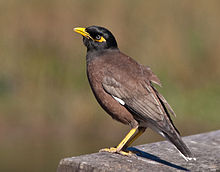
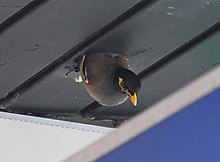
在澳洲,家八哥是一种入侵物种和害鸟。在整个澳洲东岸的城市地区,家八哥经常是主要鸟类。2008年,在一次民意投票中,家八哥被评为澳洲的“最重要的害虫/问题”。由于其数量庞大及拾荒行为,它们被称为“会飞的老鼠”,也被称为“天空中的海蟾蜍”。[5] 然而,关于它对本地物种的影响程度,科学界尚无一致共识。[46][47]
家八哥首次于1863年至1872年间被引入澳洲维多利亚州,用来控制墨尔本市场花园中的昆虫。大约同时期,该鸟可能已经扩散到新南威尔士(目前家八哥在该州最为多见),但相关记录不详。[48] 之后,家八哥被引入昆士兰以捕食蚱蜢和甘蔗甲虫。目前澳洲的家八哥种群主要集中在东部沿海地区,特别是雪梨及其周边郊区,[49] 在维多利亚州分布较稀疏,在昆士兰则有一些孤立的社区。[50] 2009年期间,新南威尔士的几个市政委员会开始尝试捕捉家八哥,以减少其数量。[51]
家八哥可以在各种气温范围内生存和繁殖,从坎培拉的寒冷冬季到凯恩斯的热带气候不等。已发现其自我维持的种群存在于月平均最高气温不低于23.2 °C(73.8 °F)和月平均最低气温不低于−0.4 °C(31.3 °F)的地区,这意味著家八哥可能会从雪梨向北扩展至凯恩斯的东海岸,向西扩展至阿德莱德的南海岸,但不会扩展至塔斯马尼亚、达尔文或内陆干旱地区。[50]
欧洲
[编辑]2019年,家八哥被列入欧盟关注的入侵外来物种名单。[52] 它们已在西班牙和葡萄牙建立了种群,[53] 并被引入法国,偶尔在当地繁殖。[54]
纽西兰
[编辑]家八哥于19世纪70年代被引入到纽西兰的北岛和南岛。然而,南岛较凉爽的夏季气温似乎阻碍了当地种群的繁殖成功率,这导致该物种无法繁衍,到19世纪90年代时,家八哥在南岛基本上已经不存在。与此相对,北岛的种群能够成功繁殖,现在大部分的北岛都有家八哥分布。然而,北岛南部地区的凉爽夏季气温,与南岛相似,亦阻止了大型家八哥种群的建立。[55][33] 自1950年代以来,家八哥已向北扩展,现在超出了怀卡托地区,[56] 主要成功的种群集中于低纬度地区,因为当地气候较为温暖。[56] 目前,家八哥在低纬度地区尤其常见,特别是在北地地区,[33] 但在旺格努伊以南的地区则较为罕见。[57]
南非
[编辑]在南非,家八哥于1902年逃入野外后变得非常普遍,其分布范围在有人类活动或人类干扰较多的地区更广。[58] 这种鸟类因其强烈的领地意识,常被认为是害鸟,会赶走其他鸟类并杀死它们的幼鸟。在南非,家八哥被视为主要的害鸟,对自然栖地造成扰乱;因此,它已被宣布为入侵物种,[59] 需要进行控制。
形态学研究显示,空间排序过程影响了A. tristis 在南非的扩散范围。[60] 与扩散相关的性状与距离种群核心的距离显著相关,并且表现出强烈的两性异形,暗示存在性别偏向的扩散。形态变异在雌鸟的翅膀和头部特征中尤为显著,这表明雌鸟是主要的扩散性别。相比之下,与扩散无关的性状,如与觅食相关的性状,未显示出空间排序的迹象,但受植被和城市化强度等环境变量显著影响。
美国
[编辑]在夏威夷,家八哥正与许多本地鸟类竞争食物和筑巢地点。[61]
为了研究A. tristis 的入侵遗传学及景观尺度动态,科学家最近使用次世代定序(NGS)方法开发了16个多态性核微卫星标记。[62]
对生态系统与人类的影响
[编辑]对本地鸟类的威胁
[编辑]家八哥是一种空洞筑巢的鸟类,即它们在天然的树洞或建筑物上的人工空洞中(例如凹陷的窗台或低矮的檐篷)筑巢繁殖。[63] 与本地空洞筑巢鸟类相比,家八哥极具攻击性,繁殖期的雄鸟会积极保护其领域,范围可达0.83公顷(但在人口密集的城市环境中,雄鸟通常只保护巢穴周围的区域)。[64]
这种攻击性使得家八哥能够取代许多本地空洞筑巢鸟类的繁殖配对,从而降低了它们的繁殖成功率。在澳洲,家八哥甚至能将像粉红凤头鹦鹉这样的大型本地鸟类赶出它们的巢穴。
此外,家八哥还会同时维护多达两个栖地;一个是靠近繁殖地的临时夏季栖地(在夏季,这是一个雄鸟社群集体过夜的地方,这也是攻击性最强的时期),另一个是全年性的永久栖地,雌鸟在那里孵蛋过夜。无论雄鸟还是雌鸟,都会激烈保护这两个栖地,进一步排挤本地鸟类。[64]
对农作物和牧场的威胁
[编辑]家八哥主要以地栖昆虫、热带水果(如葡萄、李子及某些莓果)以及城市区域的废弃人类食物为食。[65] 它对澳洲的蓝莓作物构成严重威胁,但其主要威胁仍是本地鸟类。[66]
在夏威夷,家八哥最初被引入是为了控制甘蔗作物中的粘虫和切根虫,但它反而促进了马缨丹这种顽固杂草在岛屿的开放草原上的蔓延。[67] 2004年一项夏威夷农业局的调查显示,家八哥在水果产业中被列为第四大鸟类害虫,并在所有鸟类害虫投诉中排名第六。[68]
家八哥对成熟水果造成的破坏相当大,尤其是葡萄,也包括无花果、苹果、梨、草莓、蓝莓、番石榴、芒果和面包果。邻近城市地区的谷物作物,如玉米、小麦和稻米也易受其害。与人类共同栖息和筑巢会带来美观和健康方面的问题。已知家八哥携带禽疟疾及如Ornithonyssus bursia螨这样的外来寄生虫,这些寄生虫会引发人类皮肤炎。家八哥还有助于传播农业杂草的种子,例如马缨丹,由于其侵入性,被列为“国家重大杂草”。家八哥经常被观察到夺取巢穴和空洞,摧毁本地鸟类的蛋,并杀死它们的幼鸟,包括海鸟和鹦鹉。还有证据显示家八哥曾杀死过像老鼠、松鼠和负鼠这样的小型陆地哺乳动物,但这些情况仍需要进一步研究。[69]
控制
[编辑]此章节需要扩充。 (2022年1月1日) |
家八哥作为主要的农业害鸟,并在非原产国家对本地物种构成威胁,因此受到多种因素的控制。控制家八哥的方法包括将其杀死或驱赶。目前使用的控制手段有毒药、[56] 枪击、[56] 笼式陷阱[56] 和驱鸟设备。[56]
文化中的家八哥
[编辑]在梵文文学中,家八哥有许多名称,大多描述其外观或行为。除了saarika之外,家八哥的名称还包括kalahapriya,意思是“喜欢争吵的人”,指的是这种鸟爱争吵的天性;chitranetra,意为“画眼”;peetanetra(黄眼者)以及peetapaad(黄脚者)。[70]
图库
[编辑]参考文献
[编辑]- ^ Acridotheres tristis. The IUCN Red List of Threatened Species 2012. [26 November 2013].
- ^ 2.0 2.1 Common Myna. [December 23, 2007]. (原始内容存档于2013-01-20).
- ^ Common Myna - Audubon Field Guide. Audubon. 2014-11-13 [2 March 2016]. (原始内容存档于2019-10-25).
- ^ 4.0 4.1 4.2 Lowe S., Browne M., Boudjelas S. and de Poorter M. (2000, updated 2004). 100 of the World's Worst Invasive Alien Species: A selection from the Global Invasive Species Database 互联网档案馆的存档,存档日期2017-03-16.. The Invasive Species Specialist Group (ISSG), a specialist group of the Species Survival Commission (SSC) of the World Conservation Union (IUCN), Auckland.
- ^ 5.0 5.1 ABC Wildwatch. Abc.net.au. [2012-08-07]. (原始内容存档于2012-11-09).
- ^ Brisson, Mathurin Jacques. Ornithologie, ou, Méthode contenant la division des oiseaux en ordres, sections, genres, especes & leurs variétés 2. Paris: Jean-Baptiste Bauche. 1760: 278–280, Plate 26 fig 1 (法语及拉丁语). The two stars (**) at the start of the section indicates that Brisson based his description on the examination of a specimen.
- ^ 7.0 7.1 Allen, J.A. Collation of Brisson's genera of birds with those of Linnaeus. Bulletin of the American Museum of Natural History. 1910, 28: 317–335. hdl:2246/678.
- ^ Linnaeus, Carl. Systema naturae : per regna tria natura, secundum classes, ordines, genera, species, cum characteribus, differentiis, synonymis, locis 1 12th. Holmiae (Stockholm): Laurentii Salvii. 1766: 167 (拉丁语).
- ^ Mayr, Ernst; Greenway, James C. Jr (编). Check-list of birds of the world 15. Cambridge, Massachusetts: Museum of Comparative Zoology. 1962: 112–113.
- ^ Jobling, J.A. del Hoyo, J.; Elliott, A.; Sargatal, J.; Christie, D.A.; de Juana, E. , 编. Key to Scientific Names in Ornithology. Handbook of the Birds of the World Alive. Lynx Edicions. 2018 [11 May 2018].
- ^ Vieillot, Louis Pierre. Analyse d'une Nouvelle Ornithologie Élémentaire. Paris: Deterville/self. 1816: 42 (法语).
- ^ Gill, Frank; Donsker, David (编). Nuthatches, Wallcreeper, treecreepers, mockingbirds, starlings, oxpeckers. World Bird List Version 8.1. International Ornithologists' Union. 2018 [11 May 2018].
- ^ Kannan, Ragupathy; James, Douglas A., Billerman, Shawn M.; Keeney, Brooke K.; Rodewald, Paul G.; Schulenberg, Thomas S. , 编, Common Myna (Acridotheres tristis), Birds of the World (Cornell Lab of Ornithology), 2020-03-04 [2021-08-23], doi:10.2173/bow.commyn.01 (英语)
- ^ 14.00 14.01 14.02 14.03 14.04 14.05 14.06 14.07 14.08 14.09 Ali, Salim; Ripley, S. Dillon. Handbook of the Birds of India and Pakistan, Volume 5 2 (paperback). India: Oxford University Press. 2001: 278. ISBN 978-0-19-565938-2.
- ^ 15.0 15.1 Rasmussen, Pamela C.; Anderton, John C. Birds of South Asia - The Ripley Guide (volume 2). Smithsonian Institution, Washington & Lynx edicions, Barcelona. 2005: 584, 683. ISBN 978-84-87334-66-5.
- ^ Rasmussen, PC & JC Anderton. Birds of South Asia: The Ripley Guide. Vol 2. Smithsonian Institution & Lynx Edicions. 2005: 584.
- ^ Griffin, Andrea S. Social learning in Indian mynahs, Acridotheres tristis: the role of distress calls.. Animal Behaviour. 2008, 75 (1): 79–89. S2CID 53184596. doi:10.1016/j.anbehav.2007.04.008.
- ^ 18.0 18.1 Mahabal, Anil; Vaidya, V.G. Diurnal rhythms and seasonal changes in the roosting behaviour of Indian Myna Acridotheres tristis (Linnaeus). Proceedings of Indian Academy of Sciences (Animal Science). 1989, 98 (3): 199–209 [22 January 2011]. S2CID 129156314. doi:10.1007/BF03179646.
- ^ Common Myna. [December 23, 2007].
- ^ Common Myna – Audubon Field Guide. Audubon. 2014-11-13 [2 March 2016].
- ^ Evans, Thomas; Angulo, Elena; Bradshaw, Corey J. A.; Turbelin, Anna; Courchamp, Franck. Global economic costs of alien birds. PLOS ONE. 2023, 18 (10): e0292854. Bibcode:2023PLoSO..1892854E. PMC 10584179
 . PMID 37851652. doi:10.1371/journal.pone.0292854
. PMID 37851652. doi:10.1371/journal.pone.0292854  .
.
- ^ Ubiquitous Javan Myna. Bird Ecology Study Group, Nature Society (Singapore). Besgroup.blogspot.com. [October 25, 2007].
- ^ Pell & Tidemann 1997a,第141–149页.
- ^ Pell & Tidemann 1997a,第146页.
- ^ Pell & Tidemann 1997a,第141页.
- ^ Bomford & Sinclair 2002,第35页.
- ^ Choudhury A. Common Myna feeding a fledgling koel. Journal of the Bombay Natural History Society. 1998, 95 (1): 115.
- ^ Mahabal, Anil. Activity-time budget of Indian Myna Acridotheres tristis (Linnaeus) during the breeding season. Journal of the Bombay Natural History Society. 1991, 90 (1): 96–97 [22 January 2011].
- ^ Pande, Satish; Tambe, Saleel; Clement, Francis M; Sant, Niranjan. Birds of Western Ghats, Kokan and Malabar (including birds of Goa). Mumbai: Bombay Natural History Society & Oxford University Press. 2003: 312, 377. ISBN 978-0-19-566878-0.
- ^ Lowe, Katie A.; Taylor, Charlotte E.; Major, Richard E. Do Common Mynas significantly compete with native birds in urban environments?. Journal of Ornithology. 2011-10-01, 152 (4): 909–921. ISSN 0021-8375. S2CID 3153551. doi:10.1007/s10336-011-0674-5 (英语).
- ^ 31.0 31.1 31.2 Acridotheres tristis (Common myna). Animal Diversity Web.
- ^ Mathew, DN; Narendran, TC; Zacharias, VJ. A comparative study of the feeding habits of certain species of Indian birds affecting agriculture. J. Bombay Nat. Hist. Soc. 1978, 75 (4): 1178–1197.
- ^ 33.0 33.1 33.2 Taonga, New Zealand Ministry for Culture and Heritage Te Manatu. Starlings and mynas. teara.govt.nz.
- ^ Mahabal, Anil; Bastawade, D.B. Mixed roosting associates of Indian Myna Acridotheres tristis in Pune city, India. Pavo. 1991, 29 (1 & 2): 23–32 [22 January 2011].
- ^ Mahabal, Anil. Diurnal intra- and inter-specific assemblages of Indian Mynas. Biovigyanam. 1992, 18 (2): 116–118 [22 January 2011].
- ^ Mahabal, Anil; Bastawade, D.B.; Vaidya, V.G. Spatial and temporal fluctuations in the population of Common Myna Acridotheres tristis (Linnaeus) in and around an Indian City. Journal of the Bombay Natural History Society. 1990, 87 (3): 392–398 [22 January 2011].
- ^ Mahabal, Anil. Seasonal changes in the flocking behaviour of Indian Myna Acridotheres tristis (Linnaeus). Biovigyanam. 1993, 19 (1 & 2): 55–64 [22 January 2011].
- ^ Mahabal, Anil. Communal roosting in Common Mynas and its functional significance. Journal of the Bombay Natural History Society. 1997, 94 (2): 342–349 [22 January 2011].
- ^ Mahabal, Anil. Communal display behaviour of Indian Myna Acridotheres tristis (Linnaeus). Pavo. 1993, 31 (1&2): 45–54.
- ^ Palmer; Bradshaw (编). The Mauritius Register: Historical, official and Commercial, corrected to the 30th June 1859.. Mauritius: L. Channell. 1859: 77.
- ^ Wilme, Lucienne. Composition and characteristics of bird communities in Madagascar (PDF). Biogéographie de Madagascar. 1996: 349–362.
- ^ Saavedra et al. 2015,第121–127页.
- ^ Long, John L. (1981). Introduced Birds of the World. Agricultural Protection Board of Western Australia, 21-493
- ^ Grarock, Kate; Tidemann, Christopher R.; Wood, Jeffrey; Lindenmayer, David B. Sueur, Cédric , 编. Is It Benign or Is It a Pariah? Empirical Evidence for the Impact of the Common Myna (Acridotheres tristis) on Australian Birds. PLOS ONE. 2012-07-11, 7 (7): e40622. Bibcode:2012PLoSO...740622G. ISSN 1932-6203. PMC 3394764
 . PMID 22808210. doi:10.1371/journal.pone.0040622
. PMID 22808210. doi:10.1371/journal.pone.0040622  (英语).
(英语).
- ^ Cruz & Reynolds 2019,第302-308页.
- ^ Sol, D.; Bartomeus, I.; Griffin, A. S. The paradox of invasion in birds: Competitive superiority or ecological opportunism?. Oecologia. 2012, 169 (2): 553–564. Bibcode:2012Oecol.169..553S. PMID 22139450. S2CID 253972110. doi:10.1007/s00442-011-2203-x.
- ^ Grarock et al (2013) Are invasive species drivers of native species decline or passengers of habitat modification? A case study of the impact of the common myna (Acridotheres tristis) on Australian bird species. Austral Ecology.
- ^ Hone, J. Introduction and Spread of the Common Myna in New South Wales (PDF). Emu. 1978, 78 (4): 227. Bibcode:1978EmuAO..78..227H. doi:10.1071/MU9780227.
- ^ Old, Julie M.; Spencer, Ricky-John; Wolfenden, Jack. The Common Myna (Sturnus tristis) in urban, rural and semi-rural areas in Greater Sydney and its surrounds. Emu - Austral Ornithology. 2014, 114 (3): 241–248. Bibcode:2014EmuAO.114..241O. S2CID 84731024. doi:10.1071/MU13029.
- ^ 50.0 50.1 Martin 1996,第169–170页.
- ^ Campion, Vikki. Councils assessing backyard traps to catch Indian Mynah birds. The Daily Telegraph. Australia. 2009-05-12 [2012-08-07]. (原始内容存档于2012-10-01).
- ^ List of Invasive Alien Species of Union concern – Environment – European Commission. ec.europa.eu. 19 December 2023.
- ^ Saavedra, Serguei. A survey of recent introduction events, spread and mitigation efforts of mynas (Acridotheres sp.) in Spain and Portugal.. Animal Biodiversity and Conservation. 2015, 38: 121–127. doi:10.32800/abc.2015.38.0121
 . hdl:10261/120917
. hdl:10261/120917  .
.
- ^ Dubois P.J. & J.M. Cugnasse (2015).- Les populations d'oiseaux allochtones en France en 2014 (3e enquête nationale). Ornithos : 22-2 : 72–91.
- ^ 9. – Introduced land birds – Te Ara Encyclopedia of New Zealand.
- ^ 56.0 56.1 56.2 56.3 56.4 56.5 Pest control hub – Northland Regional Council. www.nrc.govt.nz.
- ^ Myna information: study tracks history of pesky birds in New Zealand – The University of Auckland. www.auckland.ac.nz.
- ^ Peacock, Derick S.; van Rensburg, Berndt J. & Robertson, Mark P. The distribution and spread of the invasive alien Common Myna, Acridotheres tristis L. (Aves: Sturnidae), in southern Africa. South African Journal of Science. 2007, 103: 465–473.[永久失效链接]
- ^ National List of Invasive Bird Species (PDF). Government Gazette. 29 July 2016 [11 February 2021].[永久失效链接]
- ^ Berthouly-Salazar, C.; van Rensburg, B.J.; van Vuuren, B.J.; Hui, C. Spatial sorting drives morphological variation in the invasive bird, Acridotheres tristis. PLOS ONE. 2012, 7 (5): e38145. Bibcode:2012PLoSO...738145B. PMC 3364963
 . PMID 22693591. doi:10.1371/journal.pone.0038145
. PMID 22693591. doi:10.1371/journal.pone.0038145  .
.
- ^ COMMON MYNA Acridotheres tristis (PDF). Hbs.bishopmuseum.org. [18 March 2022].
No introduced species in Hawaii has elicited so much opinion as the Common Myna, perhaps in part due to its intelligence and amusing anthropomorphic qualities. Although they were thought to be of "great value to the aviculturist" in Hawaii for controlling pests (Bryan 1937b), it was also generally vilified for its noisy habits, "quarrelsome" and opportunistic nature, disturbance to domestic pigeons, fruit-eating and nest-robbing habits, and the possibility of its adversely affecting native bird populations (e.g., Finsch 1880; Wilson 1890a; Rothschild 1900; Perkins 1901, in Evenhuis 2007:75)
- ^ Berthouly-Salazar, C.; Cassey, P.; van Vuuren, B.J.; van Rensburg, B.J.; Hui, C.; le Roux, J.J. Development and characterization of 13 new, and cross amplification of 3, polymorphic nuclear microsatellite loci in the Common myna (Acridotheres tristis). Conservation Genetics Resources. 2012, 4 (3): 621–624. Bibcode:2012ConGR...4..621B. S2CID 16022159. doi:10.1007/s12686-012-9607-8. hdl:10019.1/113194
 .
.
- ^ Bomford & Sinclair 2002,第34页.
- ^ 64.0 64.1 Pell & Tidemann 1997a,第148页.
- ^ Pell & Tidemann 1997a,第147页.
- ^ Bomford & Sinclair 2002,第30页.
- ^ Pimentel, D.; Lori Lach; Rodolfo Zuniga; Doug Morrison. Environmental and Economic Costs of Nonindigenous Species in the United States. BioScience. January 2000, 50 (1): 53–56. doi:10.1641/0006-3568(2000)050[0053:EAECON]2.3.CO;2
 .
.
- ^ Koopman, ME & W C Pitt. Crop diversification leads to diverse bird problems in Hawaiian agriculture (PDF). Human–Wildlife Conflicts. 2007, 1 (2): 235–243 [2011-01-26]. (原始内容 (PDF)存档于2009-01-10).
- ^ Myna birds. 2018.
- ^ Dave, K. N. Birds in Sanskrit Literature revised. Delhi: Motilal Banarsidass Private Ltd. 2005: 468, 516. ISBN 978-81-208-1842-2.
| 这是一篇与雀形目相关的小作品。您可以通过编辑或修订扩充其内容。 |



